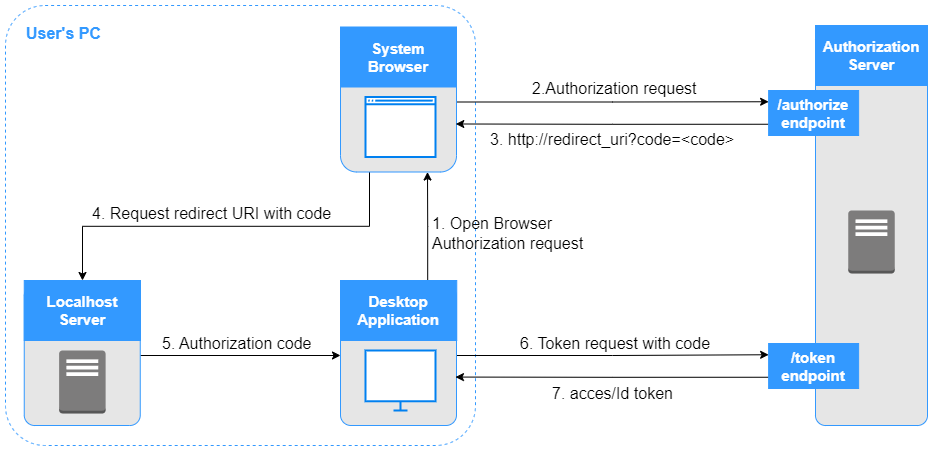Auth0: using system browser to authenticate in .NET desktop application
In previous article I described general ideas on how to integrate OAuth 2.0 authorization and authentication with desktop applications. In this article I will describe how to implement authentication in .NET desktop application with Auth0, using default system browser to perform user’s login and logout actions.
Table of contents
Auth0 nuget packages
Auth0 provides Auth0.OidcClient.WPF and Auth0.OidcClient.WinForms nuget packages, which enable developers to integrate Auth0 authorization and authentication with WPF and WinForms-based applications.
Example below presents minimal code, needed to authenticate user and acquire id_token using Auth0.OidcClient.WPF library.
string domain = ;//application domain
string clientId = ;//application clientId
client = new Auth0Client(new Auth0ClientOptions
{
Domain = domain,
ClientId = clientId
});
var loginResult = await client.LoginAsync();
var id_token = loginResult.IdentityToken;
var userClaims = loginResult.User.Claims;
Authorization code flow with PKCE is used to obtain a token
Auth0ClientOptionsclass includes IBrowser Browser {get; set;} property. IBrowser implementation takes responsibility of displaying login screen to the user. Additionally, it is used to perform user logout process.
Default implementation
By default, Auth0 nuget package uses WebViewBrowser implementation of IBrowser interface. It makes use of WebViewCompatible framework component, to display login form to the user.
WebViewBrowser renders html login page in new application window

Display Auth0 login form in system browser
In this section presents custom implementation of IBrowser interface, which displays login form using system browser.
Desired architecture
In order to display login form, system browser should be launched by desktop application, with authorization request configured as startup URL. In response, authorization server returns login page.
Once user is authenticated, application has to capture redirect URI, with authorization code provided as parameter. Since system browser is running on client machine, it can successfully resolve localhost loopback address. Application can host http server on one of the localhost ports e.g. http://localhost:8888. Once localhost address is set as redirect URI on authorization server and specified in initial authorization request, authorization code can be captured by the server.

Custom IBrowser implementation
IBrowser interface includes a single method signature:
public interface IBrowser
{
Task<BrowserResult> InvokeAsync(BrowserOptions options, CancellationToken cancellationToken = default(CancellationToken));
}
BrowserOptions, passed as an argument, specifies StartUrl and EndUrl properties
StartUrl- URL to initiate OAuth action. In case of authentication or authorization it is set to authorize request. (In the context of logout it represents/logoutendpoint request.)EndUrl- Redirect URL. (In case of logout it represents post logout redirect url.)
Below, custom, IBrowser implementation utilizes system browser to perform login and logout actions
internal class SystemBrowser : IBrowser
{
const string ERROR_MESSAGE = "Error ocurred.";
const string SUCCESSFUL_AUTHENTICATION_MESSAGE = "You have been successfully authenticated. You can now continue to use desktop application.";
const string SUCCESSFUL_LOGOUT_MESSAGE = "You have been successfully logged out.";
private HttpListener _httpListener;
private void StartSystemBrowser(string startUrl)
{
Process.Start(new ProcessStartInfo(startUrl) { UseShellExecute = true });
}
public async Task<BrowserResult> InvokeAsync(BrowserOptions options, CancellationToken cancellationToken = default)
{
StartSystemBrowser(options.StartUrl);
var result = new BrowserResult();
//abort _httpListener if exists
_httpListener?.Abort();
using (_httpListener = new HttpListener())
{
var listenUrl = options.EndUrl;
//HttpListenerContext require uri ends with /
if (!listenUrl.EndsWith("/"))
listenUrl += "/";
_httpListener.Prefixes.Add(listenUrl);
_httpListener.Start();
using (cancellationToken.Register(() =>
{
_httpListener?.Abort();
}))
{
HttpListenerContext context;
try
{
context = await _httpListener.GetContextAsync();
}
//if _httpListener is aborted while waiting for response it throws HttpListenerException exception
catch (HttpListenerException)
{
result.ResultType = BrowserResultType.UnknownError;
return result;
}
//set result response url
result.Response = context.Request.Url.AbsoluteUri;
//generate message displayed in the browser, and set resultType based on request
string displayMessage;
if (context.Request.QueryString.Get("code") != null)
{
displayMessage = SUCCESSFUL_AUTHENTICATION_MESSAGE;
result.ResultType = BrowserResultType.Success;
}
else if(options.StartUrl.Contains("/logout") && context.Request.Url.AbsoluteUri == options.EndUrl)
{
displayMessage = SUCCESSFUL_LOGOUT_MESSAGE;
result.ResultType = BrowserResultType.Success;
}
else
{
displayMessage = ERROR_MESSAGE;
result.ResultType = BrowserResultType.UnknownError;
}
//return message to be displayed in the browser
Byte[] buffer = System.Text.Encoding.UTF8.GetBytes(displayMessage);
context.Response.ContentLength64 = buffer.Length;
context.Response.OutputStream.Write(buffer, 0, buffer.Length);
context.Response.OutputStream.Close();
context.Response.Close();
_httpListener.Stop();
}
}
return result;
}
}
Once authorization code is captured, system browser displays

After successful logout, system browser displays

SystemBrowser class can be used to instantiate Auth0ClientOptions as below
private Auth0Client _client = new Auth0Client(new Auth0ClientOptions
{
Domain = ;//application domain
ClientId = ;//application clientId
Browser = new SystemBrowser(),
RedirectUri = "http://localhost:8888",
PostLogoutRedirectUri = "http://localhost:8888/logout"
});
public void Login
{
var loginResult = await _client.LoginAsync();
var id_token = loginResult.IdentityToken;
var userClaims = loginResult.User.Claims;
}
Note that given RedirectUri and PostLogoutRedirectUri need to be registered in Auth0 application settings.
Implementation considerations
Redirect URI
Proposed implementation arbitrary specifies redirect URI as http://localhost:8888. It can be considered risky to assume port 8888 is not occupied by other process in application’s target environment. In case port is already in use, authentication could not be performed.
To mitigate this risk, implementation could verify, if desired port is not occupied. In case it is occupied, other port can be verified and eventually used i.e. 8889.
Note that all possible redirect URIs needs to be registered in Auth0 application settings. As for now Auth0 does not provide an option to specify redirect URI port using wildcard (i.e. http://localhost:*). However, it is possible to register multiple localhost redirect URIs with a certain port range. Application can try to find a free port within the registered range.
HttpListener instance
In presented example, SystemBrowser holds an instance of HttpListener. Before the instance is initialized, there is _httpListener?.Abort(); executed, to close and dispose existing HttpListener instance (if there is any). This mechanism is intended for scenarios, where user initiates login, but does not complete it. In subsequent login attempt existing listener will be aborted first, before initializing new instance. Abort() causes HttpListenerException in original thread, so it needs to be handled properly.
Timeout
Presented example, for sake of simplicity, does not consider timeout. BrowserOptions, passed as input parameter, contains public TimeSpan Timeout { get; set; } property. If needed, HttpListener can be closed, if no request was captured within given timeout.